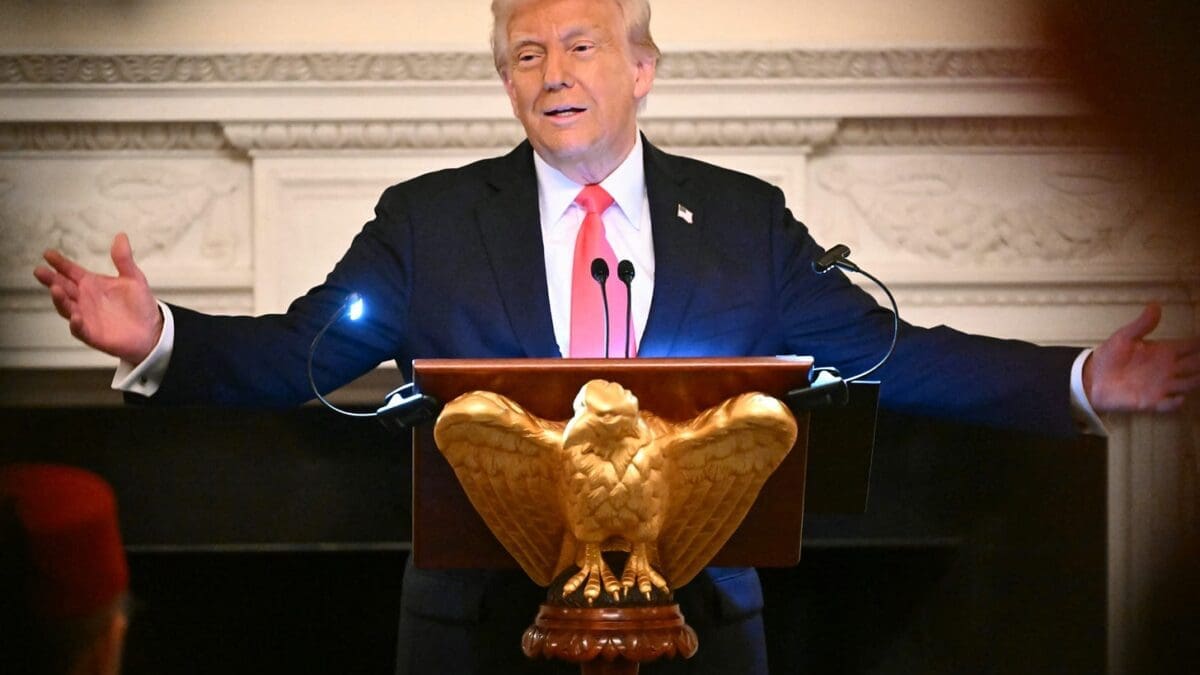Change Your Perspective, Change Your Life | New Insights On Life
March 29, 2025
Signalgate and the Trumpian Reflex to Lie
March 30, 2025AS A HISTORIAN, I FIND IT SURREAL and even a bit unnerving to read an executive order about “restoring truth in American history” that is full of outright lies. But what else is to be expected out of the Trump administration?
It’s not just about the Smithsonian Institution, or its American Art Museum, or the 250th anniversary of the Declaration of Independence. The executive order Trump signed on March 27, “Restoring Truth and Sanity to American History,” is part of a much larger project of reframing America. If you’ll forgive me for quoting George Orwell’s Nineteen Eighty-Four (banned from schools in my state of Iowa until a judge temporarily intervened), “Who controls the past controls the future. Who controls the present controls the past.”
In one sense, this pithy saying is not true: Professional historians, even if you think they control the past, have very little power over the present or the future, as the continuing demolition of the academic humanities makes plain. But the maxim is one of the bedrocks of how tyranny engages with history: crafting a mythic golden age that “they” “stole” from “us.” Totalitarians know how to tell a good story with friends and enemies, heroes and villains.
Taking into account the deportation flights, the arrests and disappearances, the visa cancellations, the ignoring of due process and judicial authority, and the bad-faith lawsuits and attacks on the rule of law, it’s clear that we’re well on our way to the massive consolidation of power that characterizes fascism. But fascism is more than simple authoritarianism. It is distinguished by a larger ideology that provides a semblance of political justification for the actions of the regime.
Trump’s executive order starts with the argument that history—the kind written and studied by academics—is a lie:
Americans have witnessed a concerted and widespread effort to rewrite our Nation’s history, replacing objective facts with a distorted narrative driven by ideology rather than truth. This revisionist movement seeks to undermine the remarkable achievements of the United States by casting its founding principles and historical milestones in a negative light. Under this historical revision, our Nation’s unparalleled legacy of advancing liberty, individual rights, and human happiness is reconstructed as inherently racist, sexist, oppressive, or otherwise irredeemably flawed. Rather than fostering unity and a deeper understanding of our shared past, the widespread effort to rewrite history deepens societal divides and fosters a sense of national shame, disregarding the progress America has made and the ideals that continue to inspire millions around the globe.
Trump claims to respect historical truth, which he contrasts with falsehoods engendered by ideology. Yet his obvious project is really not to eliminate ideology from history but to rewrite American history—to collapse the complicated, messy story of people and places into a simplified, mythical past that suits his tawdry present. In Trump’s false American past, our country has never done anything it should be ashamed of: not slavery; not genocidal wars of conquest and occupation against Native Americans; not Jim Crow; not multiple iterations of the Ku Klux Klan that could muster 60,000-man open, unmasked marches in D.C. in the 1920s; not “Indian boarding schools” and their unmarked mass graves; not the massive growth of eugenics as a science in the United States; not the White Power movement of the 1970s and 1980s.
The real point of the executive order becomes clearer the further along you read. Trump is mad about the Smithsonian American Art Museum exhibition “The Shape of Power: Stories of Race and American Sculpture” because it “claims that ‘sculpture has been a powerful tool in promoting scientific racism’ and promotes the view that race is not a biological reality but a social construct, stating ‘Race is a human invention.’” This is about as honest as the Trump administration has ever been. “Museums in our Nation’s capital,” the order preaches, “should be places where individuals go to learn—not to be subjected to ideological indoctrination or divisive narratives that distort our shared history.” Apparently, that shared reality is centered on the idea that race is a biological fact. This is not true historically or scientifically or in any other way outside the miserable, backwards swamp logic of white supremacy.
Respecting “our shared history” also apparently requires restoring statues taken down since 2020—and while I immediately thought of Columbus statues, as the Southern Poverty Law Center points out, Trump’s directive would also restore the 94 Confederate monuments removed in 2020 alone. Not only must they be re-erected: When they go back up, they must be accompanied with nice, uncritical commentary:
to ensure that all public monuments, memorials, statues, markers, or similar properties within the Department of the Interior’s jurisdiction do not contain descriptions, depictions, or other content that inappropriately disparage Americans past or living (including persons living in colonial times), and instead focus on the greatness of the achievements and progress of the American people or, with respect to natural features, the beauty, abundance, and grandeur of the American landscape.
Trump wants, for example, to present Christopher Columbus solely as a flag-planting hero despite his never having stepped foot on the American mainland and, more importantly, Columbus’s having committed so many terrible crimes that he was dragged back to Spain in chains. (I wrote about this more than once during the last Trump administration.) But Trump’s order is also intended to suppress the knowledge of the violence performed against people of color by the sorts of figures from our history first introduced to us in elementary school classrooms as cartoonish nobilities. This is not “restoring truth.” It is erasure.
To put it plainly, Trump’s order is aimed at replacing history with propaganda. Hannah Arendt, in her last public interview, spoke about this exact sort of eventuality in the context of the destruction of the free press—a context that feels, given recent events, increasingly and unsettlingly close to our own:
The moment we no longer have a free press, anything can happen. What makes it possible for a totalitarian or any other dictatorship to rule is that people are not informed; how can you have an opinion if you are not informed? If everybody always lies to you, the consequence is not that you believe the lies, but rather that nobody believes anything any longer. This is because lies, by their very nature, have to be changed, and a lying government has constantly to rewrite its own history. On the receiving end you get not only one lie—a lie which you could go on for the rest of your days—but you get a great number of lies, depending on how the political wind blows. And a people that no longer can believe anything cannot make up its mind. It is deprived not only of its capacity to act but also of its capacity to think and to judge. And with such a people you can then do what you please.
The risk is not that Americans will be misled on particular matters of fact, but that they’ll lose their respect for the idea of the truth—will capitulate to the cynical lies. This, in turn, engenders a cultural atmosphere that is inhospitable to dreams and ideals and hopes. It would be to give up our birthright of earnest optimism and our sense that we can always improve our lot and that of the world.
The final loss is of our liberty. Because American history—the sort Trump is working to erase—also teaches us that when a government becomes tyrannical, the people have rights, and courage, and the will to band together against the odds to overthrow tyrants, whether kings, Confederates, or tech oligarchs. And that is a lesson we need to remember now more than ever.
Great Job Thomas Lecaque & the Team @ The Bulwark Source link for sharing this story.







